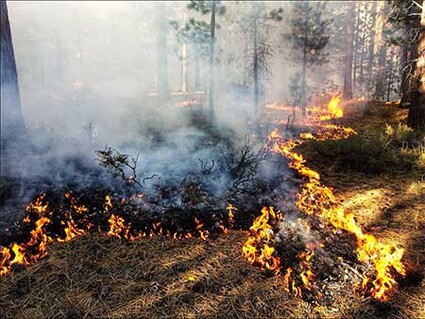Fire has to be ‘just right’ to help forest health
Last updated 3/14/2023 at Noon

Fire has to be neither too hot nor ‘too cold’ to have a positive effect on forest health, according to Oregon State University research. PHOTO PROVIDED
CORVALLIS – Oregon State University research into the ability of a wildfire to improve the health of a forest uncovered a Goldilocks effect: Unless a blaze falls in a narrow severity range, neither too hot nor too cold, it isn’t very good at helping forest landscapes return to their historical, more fire-tolerant conditions.
The study led by Skye Greenler, a graduate research fellow in the OSU College of Forestry, and Chris Dunn, an assistant professor in the college, has important implications for land managers charged with restoring ecosystems and reducing fire hazard in dry forests such as those east of the Cascade Range.
The findings, published in PLOS One, shed light on the situations in which managed wildfires, as well as postfire efforts such as thinning and planting, are likely to be most effective at achieving restoration goals.
Wildfire has shaped ecosystems for millennia, the researchers note, but its impacts have become an increasing social, economic and ecological concern across the western United States. Aggressive fire exclusion policies, forest and resource management practices, and climate change have altered forest structure and composition – increasing forests’ vulnerability to extreme wildfires and drought.
“As wildfire activity continues to intensify in the West, it’s becoming clear that a variety of management activities are necessary to make ecosystems healthier and to lower wildfire risk,” Greenler said. “Fuel reduction treatments like mechanical thinning and prescribed fire can reduce community and ecosystem risk, but in most places, the pace and scale of treatments are way below what’s needed to substantially alter fire effects and behavior.”
In an independent project, Greenler and Dunn in a collaboration with College of Forestry colleagues James Johnston, Andrew Merschel, and John Bailey developed a new way to predict the fire severities that are most apt to help eastern Oregon forests return to their historical density, species composition, and basal area, a measure of how much ground in a specific area is occupied by tree stems.
“We built probabilistic tree mortality models for 24 species based on their characteristics and remotely sensed fire severity data from a collection of burned areas,” Greenler said. “Then we looked at unburned stands in the Ochoco, Deschutes, Fremont-Winema, and Malheur national forests to model postfire conditions and compared the results to historical conditions. That let us identify which fire severities had the highest restoration potential.”
The research team, which also included scientists from the University of Washington, the U.S. Forest Service, and Applegate Forestry LLC of Corvallis, generally found that basal area and density targets could be met through fire within a fairly narrow range of moderate severity.
However, one blaze can’t restore species composition to its historical norm in a forest that evolved amid frequent, low-severity fires, the scientists found.
“Landscapes have likely passed thresholds that preclude the effectiveness of managed wildfire alone as a restoration tool,” Greenler said. “In a large number of fire-prone Western landscapes, forest structure and composition are no longer resistant or resilient to natural disturbance processes like fire, drought, and endemic insects and pathogens, and interactions among all of those.”
Although more and more wildfires are burning large areas and at high severity, the majority of fires in the West still burn at low or moderate severity, the authors note. They cite a recent analysis that found about half of the burned area in Oregon and Washington from 1985 through 2010 did so in low-severity fires.
“Low severity may be ‘too cold’ to meet restoration objectives in areas where significant tree density reduction or big shifts in tree species composition are needed,” Greenler said.
















Reader Comments(0)